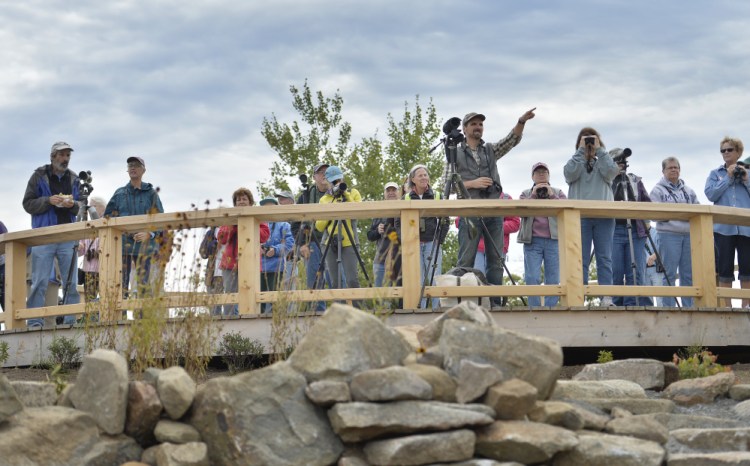YORK — Hit the right day, and it’s like hitting pay dirt: Dozens of hawks flying directly overhead close enough for the naked eye to see from the summit of Mount Agamenticus.
“The conditions have to be just right, but it’s not unusual to see a kettle of 30 hawks,” said Robin Kerr, the Mount Agamenticus conservation coordinator.
New Hampshire biologist Katrina Felton said Mount Agamenticus is a choice viewing spot in the fall, but she agreed the conditions play a key role.
“It’s pretty wind dependent,” Felton said. “A northwest wind on a sunny day will bring in the broad-wing hawks. They’re the most common migrants. People have been hawk-watching here for decades.”
Felton gave a presentation Tuesday at Mount Agamenticus on how to identify hawks, simplifying the skill for 30 birders. Another hawk presentation will be given at Mount Agamenticus this weekend, and birders will be out Sunday at 11 a.m., helping to identify passing hawks.
Tuesday the wind was minimal with overcast skies, so it wasn’t a great day to see hawks. Still, Felton’s group saw three turkey vultures, a few osprey, a Cooper’s hawk, kestrel and two marlins in the span of an hour.
Many hawk surveys take place across North America in the fall, and as many as seven have been conducted in Maine during the fall migration.

A turkey vulture soars overhead at Mount gamenticus in York, a prime bird-watching spot where birders may also participate in various presentations by nature experts.
The Bradbury Mountain hawk survey at Bradbury Mountain State Park, now in its eighth year, is the only spring hawk count in Maine and among a small percentage of spring counts in North America, according to a database of about 300 annual counts at hawkcount.org. Three surveys are scheduled this fall in Maine: at Clarry Hill in Union, in the Washington County town of Cooper, and on Cadillac Mountain in Acadia National Park.
While there is no formal hawk survey taking place atop Mount Agamenticus, it’s a great vantage point for seeing hawks heading south along the coast. A new observation deck provides a 360-degree view to the White Mountains and the southern Maine coasts.
Dan Gardoqui of York has seen plenty of hawks here. A naturalist and the founder of a nearby outdoor learning center, Gardoqui said he often comes to Mount Agamenticus to bird watch. Catch a sunny fall day, he said, and the hawks are everywhere.
“I’ve been up when it’s almost like an instant festival, it’s amazing to see so many. Those days there could be 500 passing. The third week of September is the best, with a nice northwest wind on a clear day,” said Gardoqui, executive director of White Pine Programs. “It’s toward the end of the broad-winged hawk peak now, but you can still see ospreys and eagles migrating.”
Pat Moynahan of York County Audubon, which sponsored the hawk seminar, has seen it, too.
“I once saw a golden eagle pop up the mountain riding a thermal while I was sitting here,” said Moynahan, a Biddeford resident. “In the fall, birds are spilling out of the northwest, looking for those thermals to ride. The wind is the highway they ride south.”
Felton said the key to hawk identification is to study the shapes of the wings and the tail. “If you study the shapes, you can quickly break it down from 14 potential species, to three or four,” Felton said.
Felton works with New Hampshire Audubon during the fall migration counts at observatories at Carter Hill Orchard in Concord and Pack Monadnock at Miller State Park in Peterborough. There, she helps identify as many as 10,000 to 14,000 hawks in a month – and as many as 8,000 in a single weekend.
She also has counted at the spring survey at Bradbury Mountain. “Bradbury has good views in the spring, but they don’t have the good exposure in the fall because the birds are flying north to south,” Felton said.
Shirley Patten of Newfield drove an hour and a half for Tuesday’s seminar. She said Felton’s simple formula made identifying raptors easy. Now it’s just a matter of going where the migrating birds can be seen. “Oh, absolutely we will be back,” Patten said.
“We’ll also go to Bradbury Mountain State Park. Taking this seminar made it simple. So when I see a hawk I can narrow down what species it might be.”
Send questions/comments to the editors.




Success. Please wait for the page to reload. If the page does not reload within 5 seconds, please refresh the page.
Enter your email and password to access comments.
Hi, to comment on stories you must . This profile is in addition to your subscription and website login.
Already have a commenting profile? .
Invalid username/password.
Please check your email to confirm and complete your registration.
Only subscribers are eligible to post comments. Please subscribe or login first for digital access. Here’s why.
Use the form below to reset your password. When you've submitted your account email, we will send an email with a reset code.